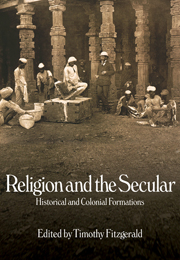Book contents
- Frontmatter
- Dedication
- Contents
- Acknowledgements
- Contributors
- Introduction
- 1 Dialectics of conversion: Las Casas and Maya colonial Congregación
- 2 A higher ground: the secular knowledge of objects of religious devotion
- 3 Secularizing the land: the impact of the Alaskan Native Claims Settlement Act on indigenous understandings of land
- 4 The formative process of State Shinto in relation to the Westernization of Japan: the concept of ‘religion’ and ‘Shinto’
- 5 Religious and secular in the Vietnam War: the emergence of highland ethno-nationalism
- 6 Colonialism all the way down? Religion and the secular in early modern writing on south India
- 7 Understanding politics through performance in colonial and postcolonial India
- 8 Real and imagined: imperial inventions of religion in colonial southern Africa
- 9 Religion in modern Islamic thought and practice
- 10 Rudolf Otto, cultural colonialism and the ‘discovery’ of the holy
- 11 Encompassing Religion, privatized religions and the invention of modern politics
- 12 Colonialism and the myth of religious violence
- Index
1 - Dialectics of conversion: Las Casas and Maya colonial Congregación
- Frontmatter
- Dedication
- Contents
- Acknowledgements
- Contributors
- Introduction
- 1 Dialectics of conversion: Las Casas and Maya colonial Congregación
- 2 A higher ground: the secular knowledge of objects of religious devotion
- 3 Secularizing the land: the impact of the Alaskan Native Claims Settlement Act on indigenous understandings of land
- 4 The formative process of State Shinto in relation to the Westernization of Japan: the concept of ‘religion’ and ‘Shinto’
- 5 Religious and secular in the Vietnam War: the emergence of highland ethno-nationalism
- 6 Colonialism all the way down? Religion and the secular in early modern writing on south India
- 7 Understanding politics through performance in colonial and postcolonial India
- 8 Real and imagined: imperial inventions of religion in colonial southern Africa
- 9 Religion in modern Islamic thought and practice
- 10 Rudolf Otto, cultural colonialism and the ‘discovery’ of the holy
- 11 Encompassing Religion, privatized religions and the invention of modern politics
- 12 Colonialism and the myth of religious violence
- Index
Summary
INTRODUCTION
The fifteenth-century arrival of Europeans along the coast and eventually inland into the American continents is mostly known to us through the writings of Europeans. This essay begins by recounting the story of one extraordinary Spaniard, Bartolomé de las Casas, an early colonist turned radical advocate of the Indians. Our sources are mostly his extensive autobiographical writings. Biographical or autobiographical narratives have a logic of their own that often seamlessly move into written histories. What we know directly from the Indians, they have written, so to speak, into the land or have left in the form of images that remain as ciphers for us to read. Writing the histories of these kinds of historical phenomena demands a different kind of looking and writing, an enthnohistorical approach through which we combine archeology, art history, oral stories and the markings of the land itself. Therefore, the second half of this essay shifts in tone, method and perspective, so that we may read land and decipher images in an attempt to write a dialectical history. Our focus will be on congregación: one of the strategies the Spanish adopted to convert Indians of the New World to Christianity. The origin of congregación begins with the thoughts of Las Casas, which he minutely records in written accounts. When it is implemented, however, conversion itself is fractured and redefined by the indigenous population it was meant to transform.
- Type
- Chapter
- Information
- Religion and the SecularHistorical and Colonial Formations, pp. 25 - 46Publisher: Acumen PublishingPrint publication year: 2007



